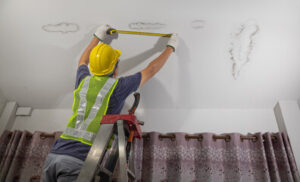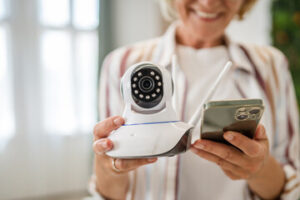Ensure that the TV mount you choose is able to hold the weight of your TV. Also, be sure that the wall bracket and mounting plate connect to each other securely.

Use a stud finder or other method to locate stud locations on your wall. Ideally, the mounting plate should span two studs. Contact TV Mounting Nashville for professional help.
A TV wall mount can help to declutter your living space, minimise the risk of children or pets tripping over cables and add value to your home if you ever choose to sell. However, it’s important to consider the ins and outs of TV mounting before you start. This includes understanding how much weight your wall mount can hold, whether it can support different types of TVs and which features are best suited to your needs.
When selecting a TV mount, you should also consider what kind of cable management it has. There are a number of different options available to hide and organize wires, including cable raceways and cord covers. These can be mounted in the wall for discreet wire exploitation, and are often paintable to match the color of your walls. Other options include wire track systems, which can be installed on the back of the TV and are designed to keep cables neatly organized and out of the way.
If you’re planning to use your TV for gaming or movie watching, a power outlet might be required at the same height as your mount. To ensure that your TV mount can accommodate this, look for a mount that has a built-in power outlet. This way, you can run your electrical cable straight from the wall to the mount without having to install a separate power outlet in your wall.
When considering a TV wall mount, it’s worth making a list of all the devices that you plan to connect to your TV, including soundbars and gaming consoles. This will help you to determine how many cables you’ll need to manage and the lengths of each. Once you’ve determined the number of cables, it’s a good idea to create a wire plan before beginning the installation. This will help you to map out how your cables will be routed and avoid any problems down the line.
Adjustability
Unlike a TV stand, a professionally mounted television is securely attached to the wall. This minimizes the likelihood of accidents and injuries resulting from falls or equipment malfunction. Moreover, mounting your TV on the wall eliminates the need for a stand, freeing up valuable space in your living room. A well-placed mount also improves the aesthetics of a room, elevating its décor and increasing its elegance.
A number of different mounts offer varying degrees of adjustability. It is important to determine your requirements before selecting a specific type of TV wall mount. For example, is your primary concern the mount’s appearance or its ability to adjust the viewing angle of the TV? If the latter, then consider options that offer swivel or tilt capability.
To ensure that the mount is properly placed on the wall, it’s best to work with a professional installer. They’ll know how to locate wooden studs and determine the proper mounting height for your TV. Additionally, they’ll be able to hide and manage cables, ensuring that the installation looks clean and professional.
Depending on the location of the TV, you may want to opt for an articulating wall mount for enhanced flexibility. This type of mount is equipped with a series of pivots and joints that allow it to extend, swivel, and tilt to accommodate different viewing angles. It’s a great option for rooms with multiple seating areas.
Another consideration when selecting a TV wall mount is the weight capacity of the product. It’s important to follow the manufacturer’s suggested weight limit for a secure and safe mount. Avoiding this limitation can result in the mount sagging, causing damage to the TV or other items.
When upgrading your TV, you’ll need to decide whether to use your existing mount or purchase a new one. It’s essential to check the compatibility of the old and new mounts, as well as to assess their condition. If the old mount is damaged or incompatible with the size and weight of your TV, it could pose a safety risk. For this reason, it’s a good idea to purchase a new mount when you upgrade your TV.
Weight Capacity
The more a TV weighs, the heavier the mount must be able to hold. For this reason, it’s important to understand your TV size and weight before buying a mount. The mount’s rated capacity is defined by its ability to distribute the TV’s weight evenly, avoiding concentrations of stress that could cause material failure. The majority of mounting brackets are crafted from robust materials like 2mm steel, making them capable of supporting TVs up to 80 kilograms in weight. However, it’s recommended to not exceed two-thirds of a mount’s rated capacity to ensure additional safety and improved durability.
When choosing a wall mount, first consider the type of wall where you’ll be installing it. If you’re putting your TV in a corner, you may want a swivel arm that allows you to adjust the screen’s angle. This will allow you to easily view the screen from multiple areas of your home and optimise its positioning for a comfortable viewing experience.
Next, check the VESA (Video Electronics Standards Association) interface pattern on the back of your TV. This is the standard mounting pattern that determines which mount will work with your model. This will help you avoid purchasing a mount that doesn’t fit and could damage your TV.
If you’re using a drywall wall, most Vogel’s mounts come with everything you need for installation, including screws and anchors that will ensure the TV mount will stay securely in place. If you’ll be installing your mount on a plaster or masonry wall, you will need to purchase the correct hardware separately.
Before drilling into your wall, use a spirit level to make sure the wall is flat and mark the spot where you’ll be drilling with a pencil. Then, use a drill to create holes at the marked spots on your wall. When drilling, if the drill hits something hard after penetrating the drywall, you’ve likely hit a stud and can continue with your installation. If you hit nothing, try again with a different location. If you’re still unable to locate the studs, have someone assist you or choose a different mounting solution.
Installation
Having the right tools and assistance is essential for successful TV mounting. Many mounts are heavy and awkward, so you will need help with lifting and positioning. A second person can also be helpful to hold the TV in place once it is attached to the wall. You will also need a drill, screwdrivers and a tape measure. It is also a good idea to pre-drill holes for the screws and use a level to ensure the mounting plate is straight on the wall. A stud finder is a handy tool to have on hand as well.
Using the measurements you took in step 5, mark where you want to mount the TV on the wall with a pencil and a tape measure. Ideally, you want to mount the TV about eye level when seated in your living room or home theater. This will make it easy to watch and avoid glare from windows or light fixtures.
Before drilling into a wall, check the weight rating of your chosen mount and the VESA compatibility of your TV. It’s also a good idea to test out the mount with your TV and any cable or satellite boxes before drilling. Once you’re ready to mount, follow the instructions that came with your mount. If you have questions, consult the manufacturer or Handyman Connection professionals for assistance.
Once you’ve drilled the holes for your mount, use a level and the bubble level to ensure the mounting plate is perfectly level before tightening. If it is not, loosen the toggle bolts and reposition it. Then, screw the toggle bolts back into place and repeat the leveling process until the plate is perfectly straight on the wall.
It is ideal to mount the TV to a stud, but this is not always possible for several reasons. If you need to mount the TV to a hollow wall, choose heavy-duty toggle bolts or molly bolts that are rated for the total weight of your TV and peripherals. Be careful not to apply too much pressure when tightening as this can cause the mount to crack the drywall.


